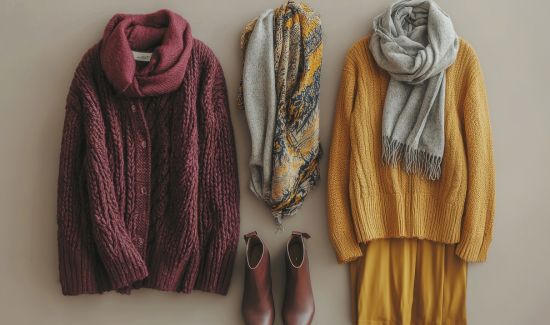- Sustainable Fashion for Each Season: Why Sustainable Fashion Matters
- Step by Step Guide to Sustainable Fashion for Each Season
- Sustainable Fashion for Each Season: How to Make Sustainable Fashion a Lifestyle
- Sustainable Fashion for Each Season: Why You Should Start Today
- Sustainable Fashion for Each Season: Ready to Make the Switch?
- FAQ's
Fashion is more than just looking good- it’s about feeling good and doing for the planet. Sustainable Fashion for Each Season is a movement that’s here to stay, and it’s all about making choices that are kind to the Earth while keeping you stylish. Whether it’s winter, spring, summer, or fall, there’s a way to dress sustainably for every season. Let’s dive into how you can make eco-friendly fashion choices all round!
Sustainable Fashion for Each Season: Why Sustainable Fashion Matters
Before we get into the seasonal tips, let’s talk about why sustainable Fashion for Each Season is so important. Did you know that the fashion industry is one of the biggest polluters in the world? Waste from water to harmful chemicals has a huge impact on the environment. But here’s the good news: choosing
Eco-friendly clothing can help reduce this damage. Plus, sustainable Fashion often supports fair wages and safe working conditions for garment workers. So, when you buy sustainable, you’re not just helping the planet- you’re helping people, too!
Step by Step Guide to Sustainable Fashion for Each Season
Let’s break it down season by season. Here’s how you can dress sustainably no matter the weather:
Sustainable Fashion for Each Season: 1 . Winter, cosy and Eco-friendly

Winter is all about staying warm, but you don’t have to sacrifice the plant to do it. Here’s how:
- Choose Natural Fiber: Look for sweaters and coats made from organic wool, alpaca, or recycled materials. These fabrics are warm, durable, and better for the environment.
- Layer Smarty: Instead to buying a new heavy coat, try layering with what you already own. A sustainable scarf or hat made from organic cotton can add warmth without waste.
- Repair and Reuse: Got a hole in your favourite winter sweater? Don’t toss it- fix it! Learning basic sewing skills can extend the life of your clothes and reduce waste.
- Pro Tip: Brands like Patagonia and Eileen Fisher offer repair services for their clothing, so you can keep your winter gear shape for years.
Sustainable Fashion for Each Season 2 Spring: Fresh Starts and Fresh Looks

Spring is the season of renewal, and it’s the perfect time to refresh your wardrobe sustainably
Sustainable Fashion for Each Season: Go for Light Fabrics:
Choose organic cotton, linen, or hemp for your spring outfits. These materials are breathable for warmer weather and biodegradable.
- Embrace Second-Hand:
Spring cleaning? Donate your old clothes and shop for vintage or second-hand pieces. Thrift stores and online platforms like ThredUp or Poshmark are great places
To find unique, eco-friendly styles.
- National dyes:
- Look for clothing dyed with
natural dyes made plans like indigo or turmeric. They’re better for the environment and
give your clothes a beautiful, earthly look.
Fun Fact: Did you know that linen is made from flax plants, which require very little water to grow? It’s one of the most sustainable fabrics out there!
Sustainable Fashion for Each Season: 3 summers- Stay Cool and Sustainable

Summer is all about staying cool and sustainable Fashion for Each Season can help you do just that.
- Lightweight and breathable: Opt for organic cotton dresses, hemp shorts, or Tencel tops. These Fabrics are lightweight, moisture-wicking, and perfect for hot days.
- Sustainable Swimwear: Love the beach?
Choose swimwear made from recycled materials like fishing nets or plastic bottlebrush, like Reformation and Summersalt offer stylish and eco-friendly options.
- Rent, Don’t Buy: For special occasions like weddings or vacations, consider renting an outfit instead of buying new Ones. Services like
Rent the Runway lets you wear designer clothes without the Personal Anecdote: Last summer, I rented a gorgeous dress for a friend’s wedding. Not only did I save money, but I also avoided adding another rarely worn dress to my closet. Win-win!
Sustainable Fashion for Each Season: 4 Fall Layers and Earthy Tones

Fall is the season of Chang, and it’s a great time to experiment with sustainable layering.
- Earthy colours: Think rust orange, olive green and deep down. These colours are not only trendy but also inspired by nature.
- Sustainable outwear: Look for jacket and costs made from recycled materials or ethical wool. Brands like Everlane and Stella McCartney offer stylish and sustainable options.
- Capsules outwear: Build a capsule wardrobe with versatile pieces that can be mixed and matched. A few high-quality items can create countless outfits, reducing the need for constant shopping.
Pro Tip: A capsule wardrobe isn’t just sustainable also saves your time getting dressed in the morning!
Sustainable Fashion for Each Season: How to Make Sustainable Fashion a Lifestyle
Now that you know how to dress sustainably for each season, here are some tips to make it a part of your everyday life: 2. Buy Less, Choose Well: Focus on quality over quantity. Invest in timeless pieces that will last for years.
- 3. Support Ethical Brands: Look for brands that prioritize for brands that prioritise fair trade, eco-friendly materials, and transparent practices., Check for certification like Trade or GOTS.
3 Repair and Upcycle: Instead of throwing away damaged clothes, repair them or turn them into something new. For example, old jeans can become trendy shorts or tote bags.
4. Educate yourself: Learn about the impact of fast fashion and share your knowledge with others. The more people know the bigger the Change we can make together.
Sustainable Fashion for Each Season: Why You Should Start Today
Switching to Sustainable Fashion for Each Season might seem like a small step, but it has a big impact. Every time you choose an eco-friendly option, you’re helping to reduce waste, save water, and protect the planet. Plus, sustainable fashion often means better quality clothes that last longer, save you money in longer, run. So, whether you’re shopping for a cosy winter coat or a breezy summer dress, remember:
Sustainable Fashion for Each Season is the way to go. It’s stylish, responsible, and good for the Earth. Start small, make mindful choices, and watch how your wardrobe and the world transform for the better.
Sustainable Fashion for Each Season: Ready to Make the Switch?
If you’re excited to start your Sustainable Fashion for Each Season journey, check out these amazing brands and resources:
- Patagonia for eco-friendly outerwear.
- Reformation for stylish, sustainable dress.
- ThredUp for second-hand fashion.
- Everlane for transparent and ethical clothing.
Remember, every small step counts. Together, we can make fashion not just beautiful but sustainable too!

FAQ‘s
What are the 5 Rs of sustainable Fashion?
The 5 Rs of sustainable Fashion are principles aimed to help consumers and brands reduce their environmental impact. They are:
Reduce: Minimise the amount of clothing you buy. Focus on quality over quantity and invest in timeless pieces that last longer.
Reuse: Extend the life of your clothes by repairing, upcycling, or donating them instead of throwing them away.
Recycle: turn old or unwanted garments into new products. Many brands now offer recycling programs for textiles.
Repurpose: Get creative with your wardrobe by transforming old clothes into something new, like turning a dress into a top or jeans into shorts.
Rethink: Change your mindset about fashion. Prioritise ethical brands, sustainable materials, and mindful consumption. These principles encourage a circular approach to fashion, reducing waste and promoting sustainability.
What are the 7 Rs of sustainable Fashion?
The 7 R’s of sustainable Fashion expand on the 5 R’s and provide a more comprehensive guide to eco-friendly practices:
Rethink: Question your buying habits. Do you need a new item, or can you make do with what you have?
Refuse: Say no to fast fashion and low-quality items that harm the environment.
Reduce: Cut down on the number of clothes you buy and focus on versatile, high-quality pieces.
Reuse: Wear you clothes for as long possible. Repair, swap, or donate them when you no longer need them.
Repair: Fix damaged items instead of discarding them. Learning basic sewing skills can save money and reduce waste.
Repurpose: Get creative and turn old clothes into new items, like bags, pillowcases, or accessories.
Recycle: Send unusable textiles to recycling programs to be turned into new materials.
These 7 R’s help create a more sustainable and circular fashion system.
What are the 52 fashion seasons?
The 52 fashion seasons refer to the concept of micro-seasons, wear brans release new collections every week instead of following the traditional tow-season model (Spring/Summer and Fall /Winter). This approach is often associated with fast fashion, as it encourages constant consumption and rapid turnover of trends.
While micro-seasons keep fashion fresh and exciting, they also contribute to overproduction, waste, and environmental harm. However, some sustainable brands are adopting a modified version of this model by releasing smaller, more frequent collections made from eco-friendly materials.
What are the 4 fashion seasons?
The 4 fashion seasons are the transitional cycles that guide the fashion industry:
1 Spring: Lightweight fabrics, pastel colors, and floral patterns dominate this season.
Summer: Bright colors, breathable materials, and casual styles are key in warm weather.
3 Fall: Earthy Tones, layering pieces, and cozy fabrics like wool and corduroy take center stage.
Winter: Heavy coats, scarves, and warm accessories are essential for staying comfortable in the cold.
These sessions have historically dictated fashion trends, but the rise of sustainable Fashion is encouraging a shift toward timeless, seasonless style that can be warm year-round.
5 What are seasonal demand trends?
Seasonal demand trends refer to the changes in consumer preferences and purchasing behavior based on the time of year. These trends are influenced by weather, holiday and cultural events.
For example,
Spring/ Summer: demand for lightweight fabrics, swimwear, and sandals increases as temperatures rise.
Fall/Winter: Consumers look for warm clothing like coats, sweaters and boots as the weather cools.
Holiday Season: Festive outfits, party wear, and give items see a spike in demand during the holiday Season.
In the context of sustainable Fashion, brands are adapting to these trends by offering eco-friendly options for each season, such as organic cotton dresses for summer or recycled wool coats for winter. By aligning with seasonal demand trends, sustainable brands can meet consumer needs while minimizing their environmental impact.💃🖤🌀❄️💮

